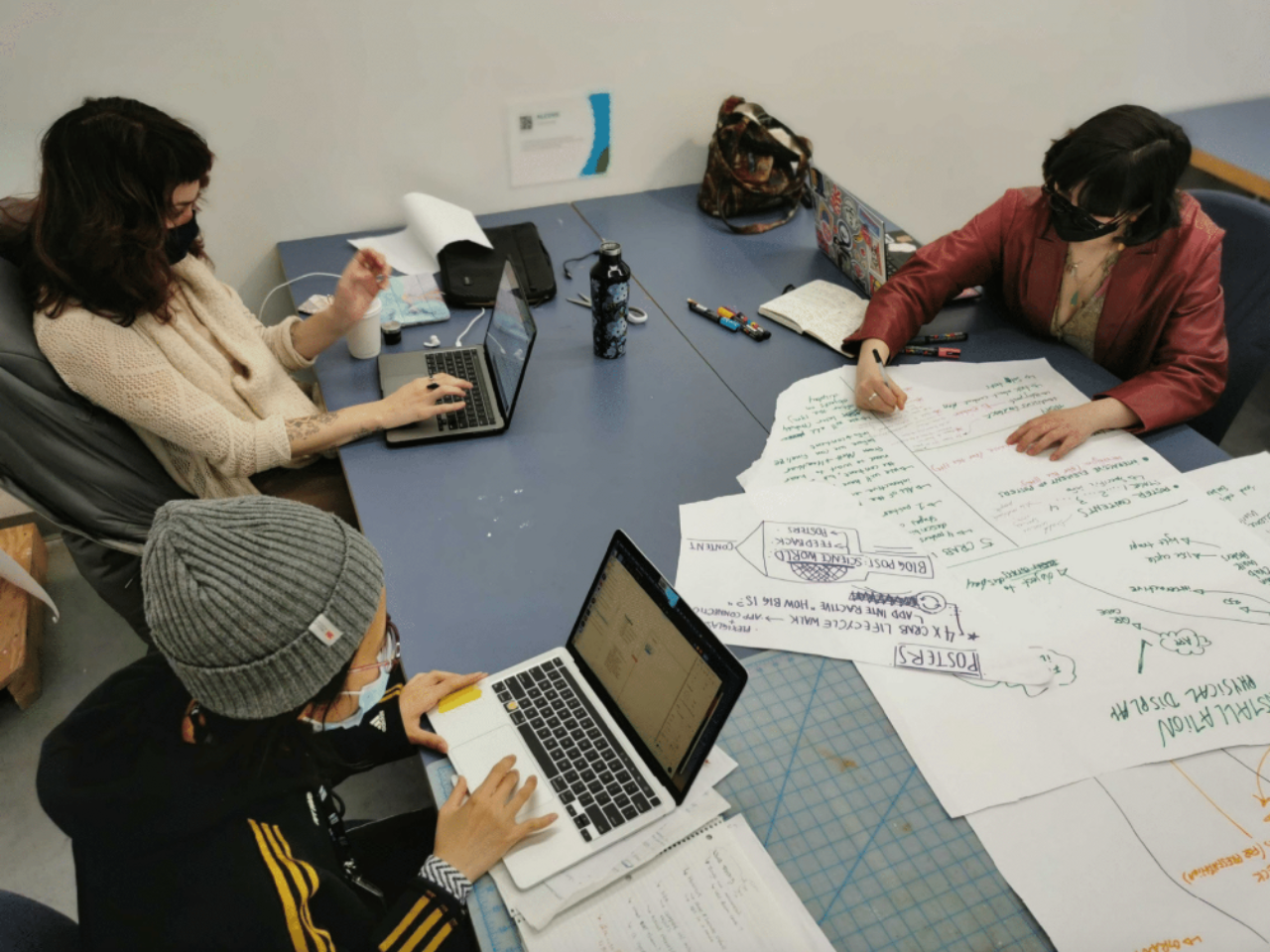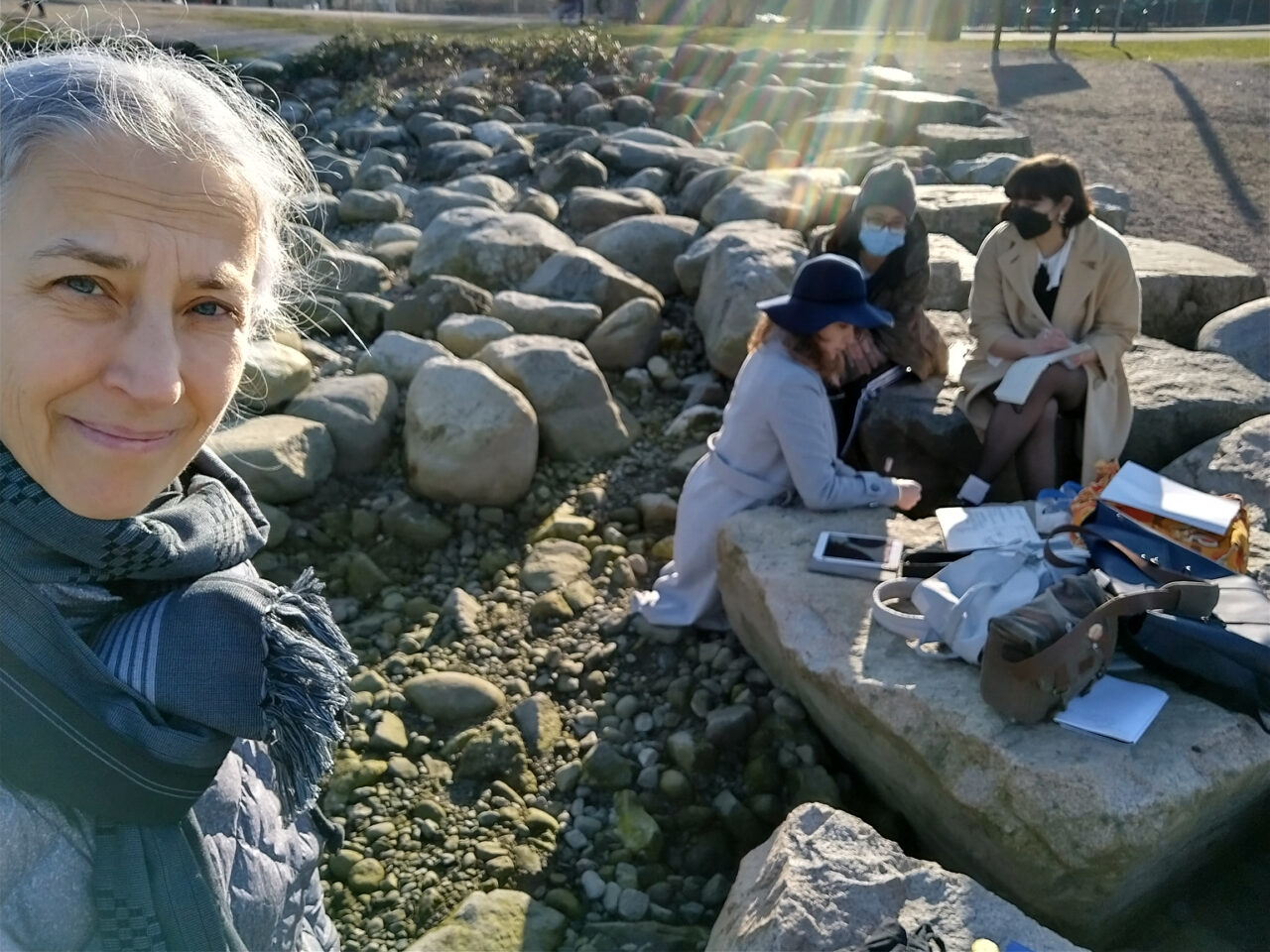Exploring False Creek’s Many Meanings Through Design

A prototype for Mattie Parker’s Community Cartography project. (Image courtesy Mattie Parker)
Posted on
Designer Eugenia Bertulis teaches students how to use Interaction Design to investigate the complex histories and functions of the local waterway.
A new course from designer and ECU faculty member Eugenia Bertulis explores Western science and Indigenous ways of knowing as lenses for understanding the False Creek waterway.
Titled “Interaction Design and Community Science,” the third-year course saw students develop projects investigating the various histories and uses of False Creek. The waterway sits at an intersection of overlapping — and often competing — interests, Eugenia tells me. It’s also emblematic of the broader colonial history of the area. For example, False Creek straddles traditional territories belonging to several Indigenous nations.
“A century or so ago, settlers came in and went, hey, we can move industrial materials in and out of False Creek,” she continues. Soon after, Indigenous communities were forcibly displaced by the Canadian government. The area quickly became crisscrossed with railway lines, the Burrard Street bridge and colonial land leases.
“Still today, people use False Creek to get around the city. It’s treated as a kind of instrument. Like, it’s a great way to move concrete in and out. It’s a great way to move things.”
This history makes it an ideal test case for interaction design students.

A collaborative working session between Weijin Ross, Ember Johnstone and Winnie Wei. (Image courtesy Weijin Ross)
This Area Is an Ancestor
Eugenia aims to teach students how to account for this history within their design work. Western science is an important tool for understanding an environment, she says. Understanding land-use law and jurisdictional authority is also crucial. This is especially true for False Creek, where 17 separate jurisdictions intersect. The city, the Park Board, the province and the federal government are each involved in the area’s management.
Just as crucial is understanding the area’s cultural and historical significance for Indigenous peoples, Eugenia continues. Students need to look at how all these interwoven interests interact.
“For better or worse, negotiations and conversations
between all those parties are, for the long-term, where we are,” she
says. “In class, we’re working with both layers. On one layer, we want
to use Western science to understand what’s going on with the waterway.
Layering on top of that, we want to understand what happens if we start
to appreciate that this area is an ancestor for some people. How do we
design for that?”
I Felt Like a Real Designer
Students developed their projects in collaboration with several outside organizations, including Iisaak Olam, Science World, False Creek Friends Society and the Hakai Foundation. They applied different tools and perspectives to their studies with each partnership.
Fourth-year interaction design student Mattie Parker created False Creek Community Cartography. The project employs “mindfulness prompts” to encourage people on the seawall to listen to their surroundings. Mattie proposed installing the prompts and QR codes onto the paved walkway around the seawall. Participants then upload their observations to the Community Cartography web app. The app then creates a map based on everyone’s input.
“This map is essentially an artistic data visualization of community observations,” Mattie tells me.
Weijin Ross is a fourth-year interaction design student with a minor in social practice and community engagement. Weijin worked with fellow students Winnie Wei and Ember Johnstone for their final project. The trio also collaborated with Hakai Foundation. The group developed interactive signage to encourage public participation during a “BioBlitz.”
For Weijin, the possibility of using design to spark a love of science was thrilling.
“One of my biggest takeaways from that class was the research we did on citizen science,” she tells me via email. “I love the idea of breaking down knowledge barriers and empowering people to get involved in cool science-y projects.”
Weijin says the group received “really awesome feedback” from Hakai’s Matt Whalen and Heather Earle.
“It was nice seeing them get excited about the project based on our sketches. At that moment, I felt like a real designer.”

Eugenia Bertulis works with students near Habitat Island in Vancouver. (Photo courtesy Eugenia Bertulis)
Redefine the Field
Throughout the semester, students learned from several guest professionals. Anishinaabe interaction designer Nodin Cutfeet presented a service-design case study. And designer and ECU faculty member Manuhuia Barcham spoke to the class about a “decolonial imaginary” for river management.
Toward the end of the course, students worked with Science World staff, including exhibit designers. They learned how the public-facing parts of their work could be tweaked or improved. They also learned about writing grants and funding — a crucial topic for any designer looking to develop a project.
“This helped inform my project a ton and really improved the quality of my work,” Mattie says.
Students also contributed to Hakai Foundation’s Sentinels of Change project. Meanwhile, Winnie Wei and Ember Johnstone secured a grant to develop their class project through the fall. The City of Vancouver asked another of Eugenia’s groups to produce a sign system for the seawall.
“It’s super exciting to hear about what the students have gone on to do,” Eugenia says. Not least because it means students are applying what they’ve learned in contexts where their expertise can make real waves, she adds.
Interaction design is too often regarded as a practice that builds websites and mobile apps, she notes. But it’s an equally effective tool for improving government and community services. It can also encourage engagement with public spaces. Approaching this work is critical to building a sustainable, equitable future.
“When these designers go out and work in the field, they help expand the definition of the role of technology in nature,” Eugenia says. “And they can bring respect for science and collaboration. That could be one forward-reaching trajectory. It could change how we think about interaction design and help redefine the field.”
Eugenia aims to teach the course again in the Spring 2024 semester.
--
Visit ECU online to learn more about studying Interaction Design at Emily Carr.